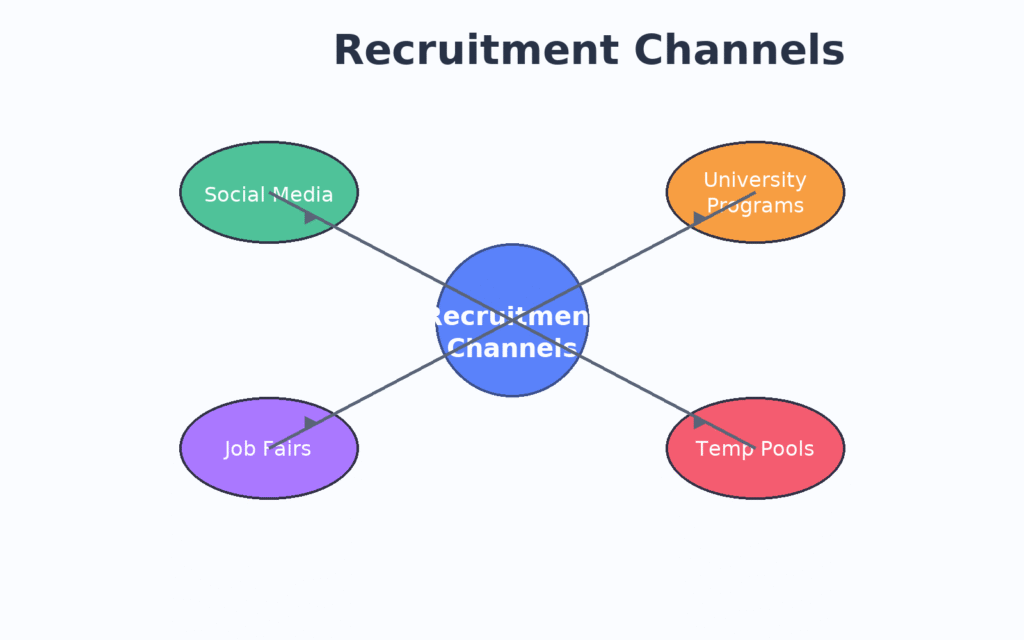
Effective Strategies for Dealing with Staffing Shortages
Workplace gaps can be detrimental to the operations throughout different sectors be it healthcare, logistics or others. Often the leaders question themselves on how to deal with staffing shortages while ensuring the quality of services, operational efficiency, and employee well-being. Well, the answer is to have planning and be proactive, positive staffing solutions and investment in long-term development. It may be a hospital that struggles with filling nursing shifts or it may be a semi-truck fleet having a lack of qualified drivers, innovative and long-term responses are required due to the safety issues involved.
How to Solve Staffing Issues: Strategies for Recruitment, Retention, and Growth | Episode: 208
Have Reskilling and Upskilling Programs
The first step to deal with such shortages is by employee training and having upskilling initiatives that prepare the team for the little changes in their roles. Instead of directly hiring from outside the organization, companies can promote the internal mobility and career ladders, supporting sustainable workforce development.
Apprenticeship Programs
Launching apprenticeship programs is a way to create the workforce pipeline to fill specialized positions. They are basically structured on the job training programs where participants learn technical skills and earn wages. In addition, logistics branches can create a pipeline of semi-truck drivers by introducing truck mechanic or truck driver apprenticeship pathways thereby, saving the need for temporary staffing.

Cross-Training Initiatives
Cross training programs provide employees the opportunity to navigate through multiples roles thereby, safeguarding the operations when the employee is sick or if the surge occurs. A nurse, for instance, who is cross-trained in both acute care and administrative could fill in the gaps in both areas. In transportation, cross-training programs allow semi-truck dispatchers to manage scheduling, enhanced scheduling, shift-swapping, and overtime management, which improves workforce resilience.
Continuous Education
Integrating continuous education into the organizational set-up is the best way to achieve this. Learning budgets, skills audits, and education stipends are very few of the things that would promote continuous education. This will help the staff expand their competencies further and it will also make them stay in the loop with the market changes. Continuous skills development will ensure higher job satisfaction and allow for the burnout prevention, thereby both being very important in long-term staff retention.
Mentorship Programs
The structured mentorship programs not only provide leadership development but also knowledge transfer. Match the seniors to the juniors workers, and in addition to the mentorship opportunities they build succession planning and encourage career advancement. The mentorship carries the message to employees and helps them steer their careers in the organization.
Solving the Skilled Labor Shortage with Innovative Strategies
Promote Work-Life Balance
The primary goal of eradicating burnout is the retention strategies. Work-life balance initiatives also help the employees to reduce stress and be more engaged. Hence work-life balance is an essential retention tool that helps organizations to keep good staff with them.

Flextime
Flextime is a well-known flexible scheduling tool. Employees can change their hours to fit their personal needs and at the same time ensure that the essential services are provided. Flextime is great for industries that require meticulous planning such as medical staffing and logistics when they must meet specific delivery or patient-care timelines.
Remote Work
The integration of a remote work or remote staffing option could assist the organizations in widening the talent pool. Administrative tasks, customer service, and even telemedicine functions could be off-site, and these would allow for greater flexible work arrangements and support operational efficiency.
Compressed Work Week
A compressed work week schedule not only gives strength but also helps to fight against burnout. Employees work four long days and get three days off, rather than the other way around this is because the time is longer for each shift. Shift swapping, in combination, will enhance the service coverage while maintaining the well-being of employees.
Increase Employee Engagement and Retention
Finding a solution to staffing shortages is not only about hiring people but also about keeping the workforce happy and motivated to perform. Strong retention policies help build organic loyalty, thus curbing turnover.
Competitive Compensation and Benefits
Emphasizing fair payment and many benefits that are attractive to the workforce is a crucial strategy. Pay for performance schemes, healthcare plans, and retirement accounts contribute a lot to the employee’s decision of remaining with the company. In areas where the workforce is scarce, such as semi-truck fleets vying for drivers, the combination of competitive wages and good management of overtime plus incentive stability assurance would be effective.
Professional Development Opportunities
Incorporating professional development opportunities is equally important. Employees see real value in having promotional opportunities, training partnerships and a path of professional growth. Programs like internship programs, recruitment partnerships, or internal hiring confirm long-term career commitment, which is why they are the most effective approaches to talent acquisition.
How Do You Deal With Staffing Shortages? | Episode 130

Use Technology and Automation
The extra burden on already overstretched teams could be taken off by tech and automation while they also improve accuracy, service delivery.
Implement Telehealth Services
In the area of health, telehealth services give the staff a chance to do remote consultations thus taking some load off the already existing staff on duty. This means also that they can create the invisible staffing without the immediate hiring requirement thus assisting overall healthcare staffing flexibility.
Automate Routine Tasks
Automated repetitive tasks like payroll, scheduling, and supply chain tracking free up employees to work on more valuable tasks. For instance, trucking companies use route optimization software for recruitment automation to source drivers more efficiently while relieving the pressure of worker shortages.
Use Electronic Health Records
In healthcare, electronic health records help in fast and accurate documentation. They easily mesh in with the workforce planning systems to make a seamless connection that decreases administrative strain. Organizations that are looking to advance their workforce and keep their staffing solutions need this integration.
Expand Recruitment Strategies

Creativity and foresight play a prominent role in staffing strategies, thus organizations should anticipate changes in the labor market and adapt accordingly.
Broaden Recruitment Pool
Employers can make the best use of still untapped resources by widening the outreach for candidates. Candidate sourcing via recruitment marketing campaigns, targeted job fairs, and social media is a good way to expand company reach. Also, employing contingent workers or setting up temp staffing pools helps mitigate the seasonal or unexpected shortage of employees.
Partner with Educational Institutions
Educational partnerships with universities, trade schools, and community colleges will enhance the talent pool. For example, the truck-driving schools training partnerships will generate the direct workforce of semi-truck operators. Likewise, hospitals may offer education stipends or employ train-and-hire models for nursing students, thus, ensuring a continuous staff supply.
Implement Train-and-Hire Models
Models that train and hire allow companies to develop their workforce while at the same time addressing immediate needs. Candidates take part in the skills development before they are assigned to the permanent roles. This process helps visionary employees and it also supports the longevity of stability.

Conclusion
The thought of how to deal with staffing shortages encompasses everything that a fast solution and beyond entails. The ecosystem of employee engagement, skills and professional development, being sustainably bent on staffing solutions, and resilience in recruitment are all you need for the turnover rate to go down.
Similar to the situation in healthcare, the logistics operations of semi-truck fleets also differ at the core — how to cover the unions while maintaining the employee’s satisfaction. Leaders must be careful and invest in people and technology either in recruitment and automation perspectives or the mentorship programs and apprenticeship programs. With a focus on workforce development, employee retention, and talent mobility, companies can navigate today’s world workforce shortages while preparing for tomorrow’s demands.
